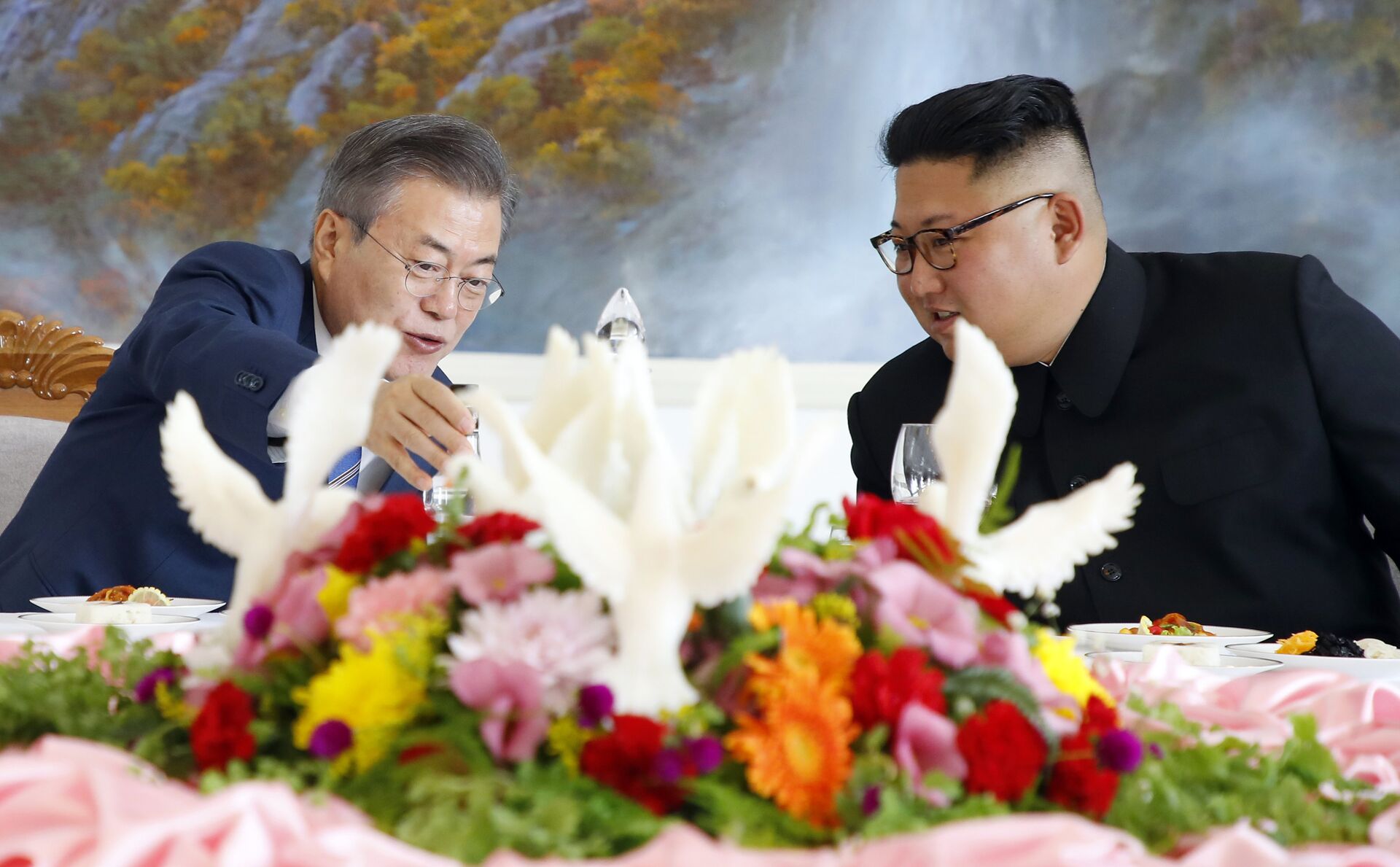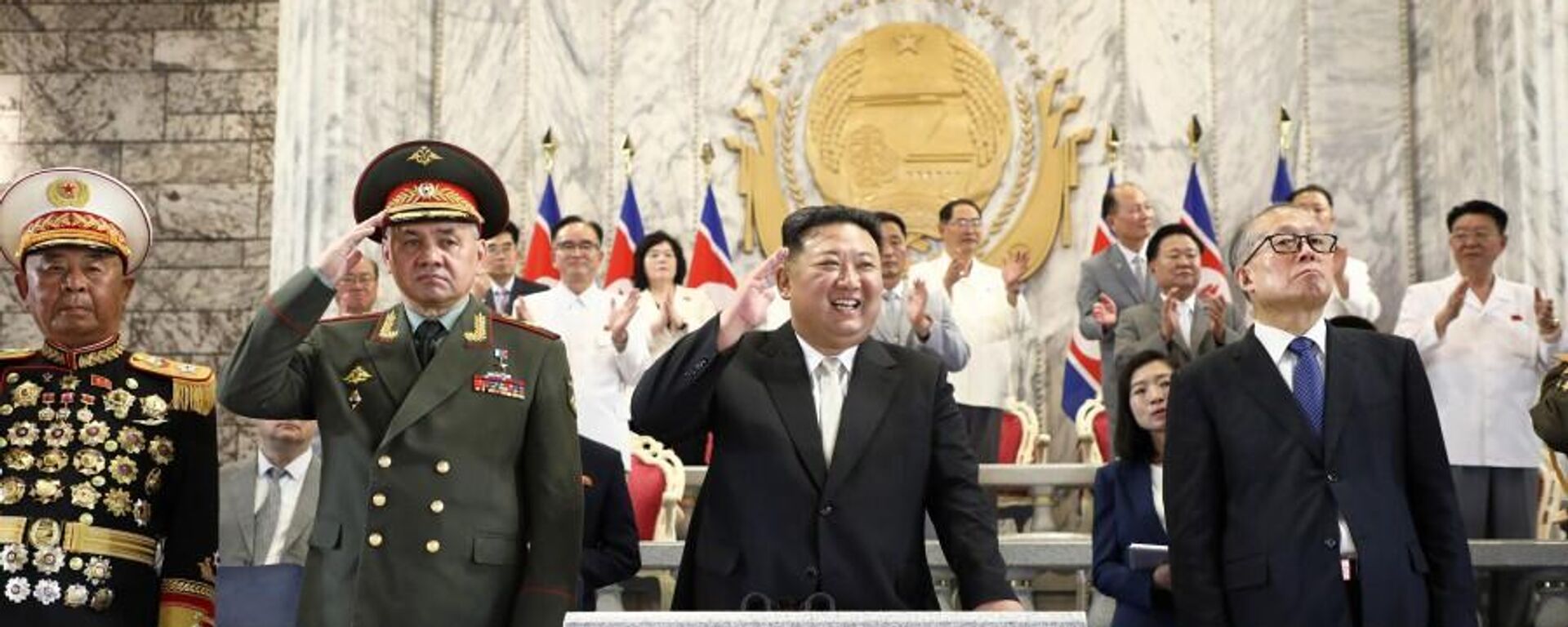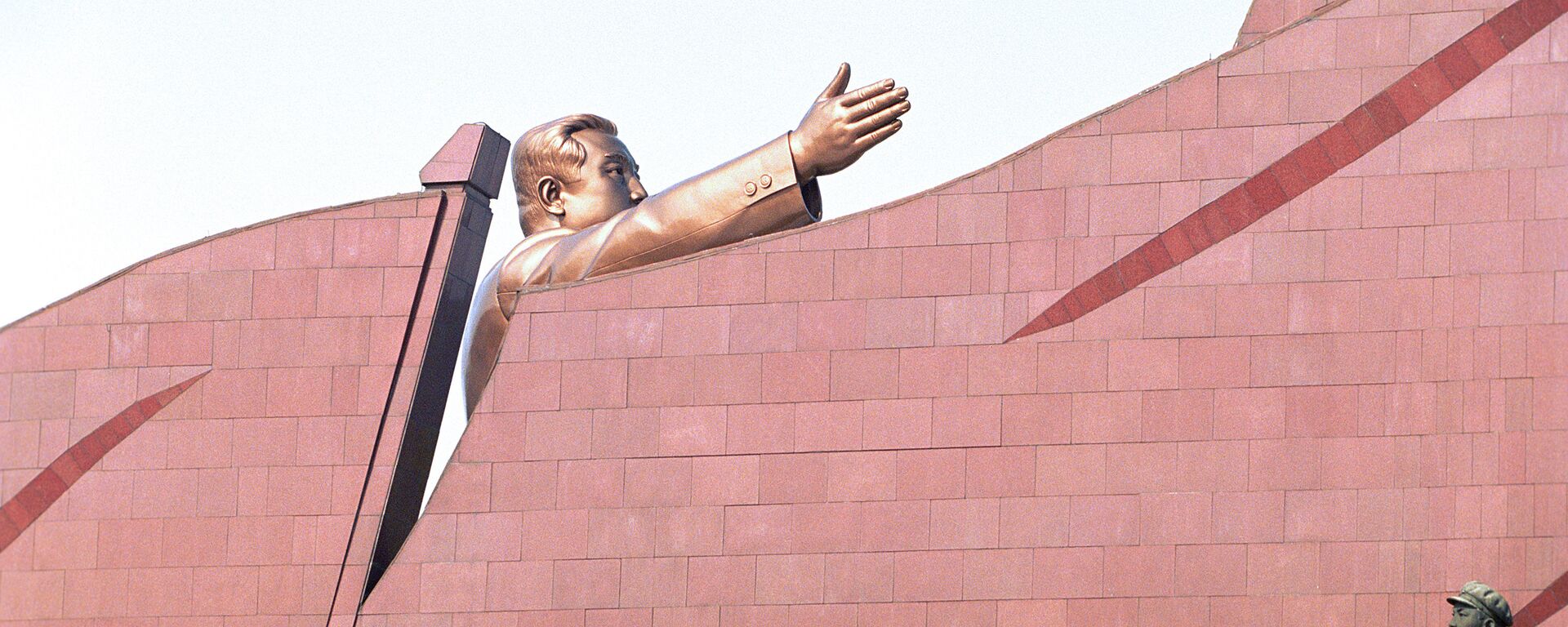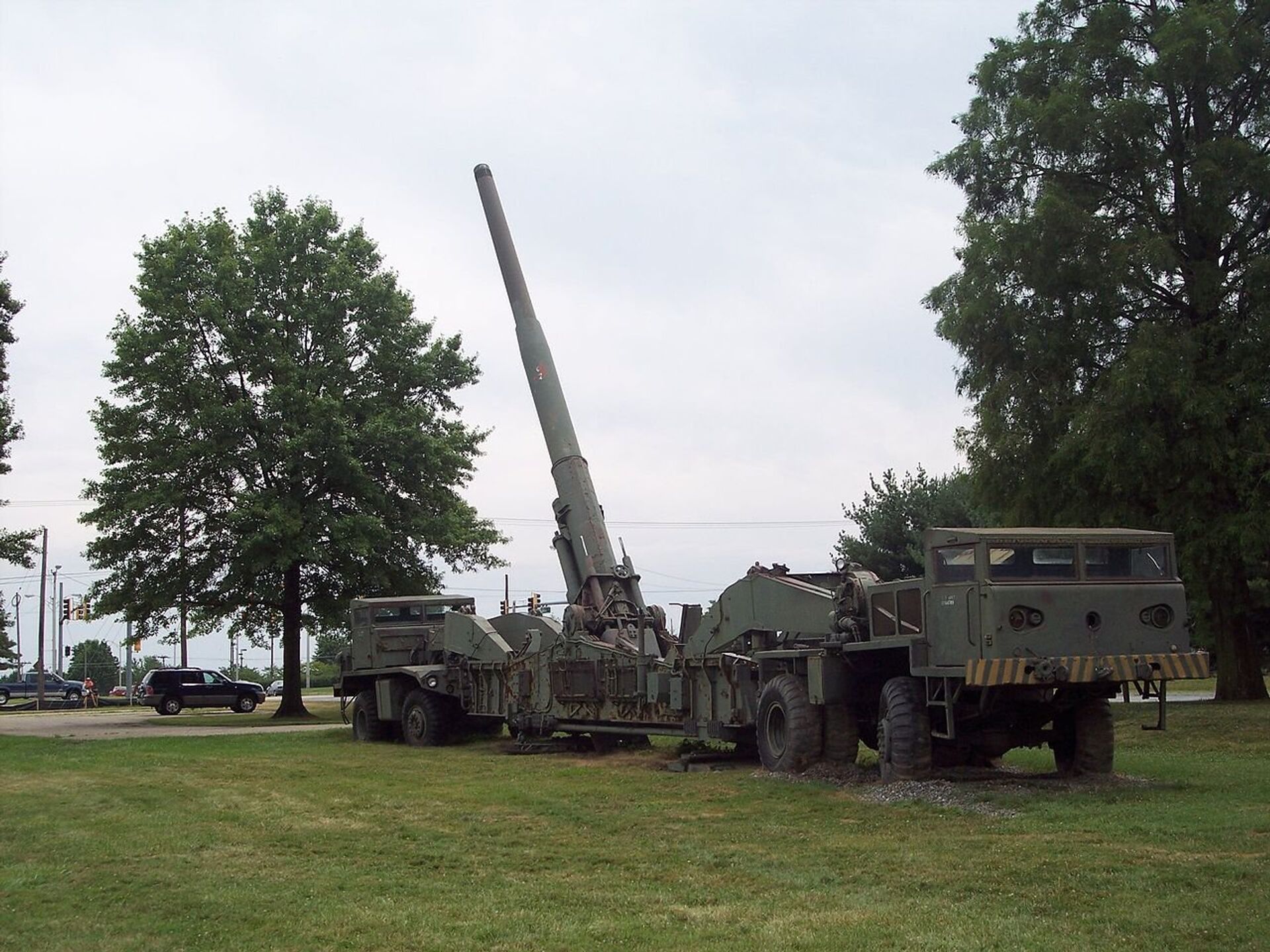https://sputnikglobe.com/20230728/70-years-of-uncertain-peace-making-of-the-1953-korean-war-ceasefire-1112227639.html
70 Years of 'Uncertain Peace': Making of the 1953 Korean War Ceasefire
70 Years of 'Uncertain Peace': Making of the 1953 Korean War Ceasefire
Sputnik International
On July 27, 1953, representatives from the two sides of the Korean War signed an armistice agreement in Panmunjom, a village just north of the line of control, establishing a ceasefire across the Korean Peninsula.
2023-07-28T21:03+0000
2023-07-28T21:03+0000
2024-01-05T15:12+0000
sputnik explains
chinese people's volunteer army (pva)
south korea
korean war
armistice
north korea
korean peninsula
https://cdn1.img.sputnikglobe.com/img/103353/56/1033535609_0:191:2048:1343_1920x0_80_0_0_dc0df2938d09adc00a6128c38bbcbc35.jpg
On July 27, 1953, representatives from the two sides of the Korean War signed an armistice agreement in Panmunjom, a village just north of the line of control, establishing a ceasefire across the Korean Peninsula. The agreement was intended to pave the way for a permanent peace treaty that has never materialized, leaving a tense standoff in place for the 70 years since.The day was marked on Thursday with different commemorations in the two Koreas, with the socialist government in Pyongyang remembering the war as a victory against US imperialism and casting its survival as a continued thumb in the face of Washington and the capitalist government in the South. In Seoul, the mood was more somber, but used by conservative President Yoon Suk Yeol to play up the "threat" posed by the Democratic People’s Republic of Korea (DPRK), the official name for the North.Sputnik takes a look back at the events of 1953 that gave birth to the ceasefire, ending a war that claimed 3 million lives, and the reasons that a permanent peace agreement was never arrived upon.From Dynamic War to StalemateBy December 1950, the United States was already searching for a way to end the conflict after facing a major reversal of fortunes and being forced to evacuate its forces from Pyongyang.Four months earlier, the decisive United Nations amphibious assault on Incheon, a DPRK-controlled city more than 100 miles behind the front lines, had taken pressure off the besieged Republic of Korea (RoK) city of Busan, the last holdout of President Syngman Rhee. The Korean People's Army (KPA) forces had been forced to hastily withdraw northward, and the US-led United Nations forces invaded far into the North’s territory.By October, UN forces had advanced so far that China intervened in the conflict as they approached the China-DPRK border, sending hundreds of thousands of men into the conflict under North Korean command as the People’s Volunteer Army (PVA). The tidal wave of troops reversed the course of the war, forcing the Americans into retreat. After a series of stunning defeats, the US-led forces evacuated Pyongyang, the largest city in the North, and were forced back to near the 38th Parallel by mid-December, not far from either the pre-war dividing line or the post-armistice Demilitarized Zone.However, the PVA-KPA momentum quickly sputtered out between their troops being exhausted by months of fighting and a host of other logistical problems, and a UN counteroffensive recaptured Seoul in March. By July 1951, the front had stabilized into a bloody stalemate, with little territory being exchanged over the next two years.The Slow March Toward CeasefireUN talk of a ceasefire resurfaced in May and June of 1951, but was strongly opposed by Rhee, who retained a desire to reunify all of Korea under his rule. DPRK leader Kim Il-Sung was no less adamant about reunifying Korea under socialist rule, but unlike Rhee, Kim assented to ceasefire talks when the UN ignored Rhee’s objections and sent peace envoys to Pyongyang anyway.Talks concerning an armistice began on July 10, 1951, in the city of Kaesong, just inside DPRK-controlled territory, but soon moved to Panmunjom following controversy over what might have been an attack on the site by UN forces. They proceeded on a set of discussion items laid out in the weeks before and which continued to guide the talks until the final agreement was signed in 1953. They included:The biggest sticking point was prisoners-of-war (POWs): while the PVA-KPA forces held some 10,000 POWs, the UN forces had captured more than 150,000 troops. Talks went very slowly, but picked up speed after India took over the repatriation commission.Talks further accelerated following the death of Soviet leader Josef Stalin in March 1953. While the Soviet Union was not party to the talks, the fellow socialist state had given substantial military-technical and intelligence assistance to Chinese and North Korean forces, as well as sent its fighter pilots to patrol the skies over the DPRK. The new Soviet leadership wasted little time voicing its support for a quick peace agreement in Korea.A unique aspect of the agreement reached on July 27, 1953, is that it is a ceasefire between military forces and not between governments. That is how the agreement did not automatically normalize relations between the two sides, or lead to a peace treaty.Geneva Talks FailA key article of the Armistice Agreement, Article IV Paragraph 60, called on all conflict parties to attend a political conference within three months of its signing "to ensure the peaceful settlement of the Korean question." Such a conference was never called, but the topic was taken up at another summit in Geneva, Switzerland, in April 1954, nine months after the armistice was signed, to deal with a very different topic: Vietnam.At the Korean meeting were delegates from the US, USSR, People’s Republic of China, North Korea, and South Korea. The Americans remained mostly aloof from the talks, however, and backed the South Korean proposals. Officials claimed Moscow wanted to turn Korea into a puppet state, mirroring its position on the reunification of Germany that had led to the creation of separate East and West German republics in 1949. Meanwhile, China and the Soviet Union issued declarations supporting a reunified Korea.The Korean delegations agreed on basically nothing: the North’s delegation wanted all foreign troops to leave Korea, and then to hold Korea-wide elections run by an all-Korean commission made up of equal parts North and South Korean members, and to increase economic and cultural relations between the two territories. However, the South’s delegation only wanted UN-supervised elections in the North and for Chinese forces to withdraw, while the US-led UN forces remained in the country as a “police force.”The standoff became even more dangerous, however, when the US decided to unilaterally abrogate Paragraph 13d of the armistice, which said neither side would bring new weapons into Korea except when trading out similar equipment. Ignoring the concerns of its allies, the US dispatched nuclear-tipped missiles and atomic artillery cannons in 1958, which soon included nuclear-tipped cruise missiles and even a type of landmine with a nuclear fission explosive. Pyongyang responded by asking Moscow and Beijing to help it develop nuclear weapons, but both powers declined; the DPRK eventually tested its own nuclear device in 2006.The other half of the Geneva conference was more substantive: the UK, US, USSR, China, France, and Viet Minh agreed to separate Vietnam into two territories that would be reunited pending the results of elections scheduled for 1956. North Vietnam, controlled by the communist Viet Minh, had soundly defeated the French in the siege of Dien Bien Phu, with the fort surrendering during the Geneva proceedings. However, the former Nguyen-dynasty emperor Bao Dai was put in power in South Vietnam, where French forces retained control, and the US looked to prevent a total communist takeover. The 1956 elections were canceled after it was realized that a communist victory was all but assured, and the stage was set for what became the Second Indochina War - in America called the Vietnam War, and in Vietnam called the Resistance War Against the United States.The People’s Volunteer Army stayed in the DPRK until 1958, helping to oversee five years of dramatic postwar reconstruction jointly sponsored by the PRC and USSR before withdrawing. However, the US has retained a 28,500-strong garrison in South Korea ever since, which has been a major sticking point between any separate rapprochement between the two Koreas, such as was attempted in 2018-19.2018 Panmunjom DeclarationFollowing years of tense standoff that included US-South Korean drills rehearsing a “decapitation strike” against DPRK leader Kim Jong Un and DPRK tests of a thermonuclear device and an intercontinental ballistic missile, the two Koreas suddenly reached toward rapprochement in early 2018 as South Korea prepared to host the Winter Olympics in Pyeongchang that February. The two Koreas entered the stadium as a joint delegation under a flag portraying a reunited Korea, although their athletes competed separately afterward.Further talks between Kim and Moon continued through 2018, leading to visits to each others’ capital cities, an increase in cultural and economic exchanges, and the repatriation of soldiers’ remains, among other friendly actions.The Panmunjom Declaration helped pave the way for further talks between Kim and then-US President Donald Trump, first in Singapore and later in Hanoi, which ultimately fell apart. The US refused to lower its economic sanctions against the DPRK before seeing proof of irreversible and verifiable denuclearization steps, despite the North dynamiting its primary test site at Punggye-ri and shutting down the nuclear reactor at Yongbyon used to make weapons fuel.Ultimately, the US was unwilling to withdraw from South Korea and Seoul was unwilling to part with its ally, and the resumption of joint military drills after the collapse of the US-DPRK talks significantly cooled inter-Korean relations. The election of Yoon Suk Yeol, a strongly conservative and anti-DPRK politician, in March 2022 essentially spelled the end to the rapprochement.
https://sputnikglobe.com/20230728/north-korea-showcases-military-might-during-pyongyang-parade-1112204695.html
https://sputnikglobe.com/20230628/the-73-year-long-war-how-cold-war-rivalries-set-off-the-korean-conflict-1111503385.html
south korea
north korea
korean peninsula
Sputnik International
feedback@sputniknews.com
+74956456601
MIA „Rossiya Segodnya“
2023
News
en_EN
Sputnik International
feedback@sputniknews.com
+74956456601
MIA „Rossiya Segodnya“
Sputnik International
feedback@sputniknews.com
+74956456601
MIA „Rossiya Segodnya“
korean war; armistice; ceasefire; dprk; south korea
korean war; armistice; ceasefire; dprk; south korea
70 Years of 'Uncertain Peace': Making of the 1953 Korean War Ceasefire
21:03 GMT 28.07.2023 (Updated: 15:12 GMT 05.01.2024) Longread
At the end of World War II, a Korean peninsula halfway liberated from Japanese colonialism became the stage for the first major showdown of the Cold War. A brutal civil war between rival communist and capitalist governments drew in world powers with a stake in the outcome, and an estimated 3 million people were killed.
On July 27, 1953, representatives from the two sides of the Korean War signed an armistice agreement in Panmunjom, a village just north of the line of control, establishing a ceasefire across the Korean Peninsula. The agreement was intended to pave the way for a permanent peace treaty that has never materialized, leaving a tense standoff in place for the 70 years since.
The day was marked on Thursday with different commemorations in the two Koreas, with the socialist government in Pyongyang remembering the war as a
victory against US imperialism and casting its survival as a continued thumb in the face of Washington and the capitalist government in the South. In Seoul, the mood was more somber, but used by conservative President Yoon Suk Yeol to play up the "threat" posed by the Democratic People’s Republic of Korea (DPRK), the official name for the North.
Sputnik takes a look back at the events of 1953 that gave birth to the ceasefire, ending a war that claimed 3 million lives, and the reasons that a permanent peace agreement was never arrived upon.
From Dynamic War to Stalemate
By December 1950, the United States was already searching for a way to end the conflict after facing a major reversal of fortunes and being forced to evacuate its forces from Pyongyang.
Four months earlier, the decisive United Nations amphibious assault on Incheon, a DPRK-controlled city more than 100 miles behind the front lines, had taken pressure off the besieged Republic of Korea (RoK) city of Busan, the last holdout of President Syngman Rhee. The Korean People's Army (KPA) forces had been forced to hastily withdraw northward, and the US-led United Nations forces invaded far into the North’s territory.
By October, UN forces had advanced so far that China intervened in the conflict as they approached the China-DPRK border, sending hundreds of thousands of men into the conflict under North Korean command as the
People’s Volunteer Army (PVA). The tidal wave of troops reversed the course of the war, forcing the Americans into retreat.
After a series of stunning defeats, the US-led forces evacuated Pyongyang, the largest city in the North, and were forced back to near the 38th Parallel by mid-December, not far from either the pre-war dividing line or the post-armistice Demilitarized Zone.
The US-led UN force offered a ceasefire on December 11, 1950, but it was rejected by the Chinese government following the dramatic successes of the recent months. Two weeks later, the PVA and KPA launched the Third Phase Offensive, a daring night attack that caught UN forces by surprise and allowed the recapturing of Seoul just days later.
However, the PVA-KPA momentum quickly sputtered out between their troops being exhausted by months of fighting and a host of other logistical problems, and a UN counteroffensive recaptured Seoul in March. By July 1951, the front had stabilized into a bloody stalemate, with little territory being exchanged over the next two years.
The Slow March Toward Ceasefire
UN talk of a ceasefire resurfaced in May and June of 1951, but was strongly opposed by Rhee, who retained a
desire to reunify all of Korea under his rule. DPRK leader Kim Il-Sung was no less adamant about reunifying Korea under socialist rule, but unlike Rhee, Kim assented to ceasefire talks when the UN ignored Rhee’s objections and sent peace envoys to Pyongyang anyway.
Talks concerning an armistice began on July 10, 1951, in the city of Kaesong, just inside DPRK-controlled territory, but soon moved to Panmunjom following controversy over what might have been an attack on the site by UN forces. They proceeded on a set of discussion items laid out in the weeks before and which continued to guide the talks until the final agreement was signed in 1953. They included:
Establishing a military demarcation line between the two armies, which would serve as the basis for a demilitarized zone, as the most basic condition for the cessation of hostilities
Establishing a supervisory organization to carry out the terms of the truce and armistice
Arrangements for the return of prisoners-of-war held by both sides
Recommendations to the governments of all countries involved
The biggest sticking point was prisoners-of-war (POWs): while the PVA-KPA forces held some 10,000 POWs, the UN forces had captured more than 150,000 troops. Talks went very slowly, but picked up speed after India took over the repatriation commission.
Talks further accelerated following the death of Soviet leader Josef Stalin in March 1953. While the Soviet Union was not party to the talks, the fellow socialist state had given substantial military-technical and intelligence assistance to Chinese and North Korean forces, as well as sent its fighter pilots to patrol the skies over the DPRK. The new Soviet leadership wasted little time voicing its support for a quick peace agreement in Korea.
A unique aspect of the agreement reached on July 27, 1953, is that it is a ceasefire between military forces and not between governments. That is how the agreement did not automatically normalize relations between the two sides, or lead to a peace treaty.
A key article of the Armistice Agreement, Article IV Paragraph 60, called on all conflict parties to attend a political conference within three months of its signing "to ensure the peaceful settlement of the Korean question." Such a conference was never called, but the topic was taken up at another summit in Geneva, Switzerland, in April 1954, nine months after the armistice was signed, to deal with a very different topic: Vietnam.
The 1954 Geneva talks featured two separate delegations: one to discuss the breakup of French Indochina, a colony in Southeast Asia in which pro-independence insurgencies had all but defeated French colonial forces and which would yield the nation-states of Vietnam, Laos, and Cambodia; and another to address the outstanding issues in Korea.
At the Korean meeting were delegates from the US, USSR, People’s Republic of China, North Korea, and South Korea. The Americans remained mostly aloof from the talks, however, and backed the South Korean proposals. Officials claimed Moscow wanted to turn Korea into a puppet state, mirroring its position on the reunification of Germany that had led to the creation of separate East and West German republics in 1949. Meanwhile, China and the Soviet Union issued declarations supporting a reunified Korea.
The Korean delegations agreed on basically nothing: the North’s delegation wanted all foreign troops to leave Korea, and then to hold Korea-wide elections run by an all-Korean commission made up of equal parts North and South Korean members, and to increase economic and cultural relations between the two territories. However, the South’s delegation only wanted UN-supervised elections in the North and for Chinese forces to withdraw, while the US-led UN forces remained in the country as a “police force.”
The Korean part of the conference ended on June 15 with no agreements and no outcomes aside from maintenance of the current position: a DMZ separating two Korean states, patrolled by both sides, across which a military standoff has endured ever since.
The standoff became even more dangerous, however, when the US decided to unilaterally abrogate Paragraph 13d of the armistice, which said neither side would bring new weapons into Korea except when trading out similar equipment.
Ignoring the concerns of its allies, the US dispatched nuclear-tipped missiles and atomic artillery cannons in 1958, which soon included nuclear-tipped cruise missiles and even a type of landmine with a nuclear fission explosive. Pyongyang responded by asking Moscow and Beijing to help it develop nuclear weapons, but both powers declined; the DPRK eventually
tested its own nuclear device in 2006.
The other half of the Geneva conference was more substantive: the UK, US, USSR, China, France, and Viet Minh agreed to separate Vietnam into two territories that would be reunited pending the results of elections scheduled for 1956.
North Vietnam, controlled by the communist Viet Minh, had soundly defeated the French in the siege of Dien Bien Phu, with the fort surrendering during the Geneva proceedings. However, the former Nguyen-dynasty emperor Bao Dai was put in power in South Vietnam, where French forces retained control, and the US looked to prevent a total communist takeover.
The 1956 elections were canceled after it was realized that a communist victory was all but assured, and the stage was set for what became the
Second Indochina War - in America called the Vietnam War, and in Vietnam called the Resistance War Against the United States.
The People’s Volunteer Army stayed in the DPRK until 1958, helping to oversee five years of dramatic postwar reconstruction jointly sponsored by the PRC and USSR before withdrawing. However, the US has retained a 28,500-strong garrison in South Korea ever since, which has been a major sticking point between any separate rapprochement between the two Koreas, such as was attempted in 2018-19.
2018 Panmunjom Declaration
Following years of tense standoff that included US-South Korean drills rehearsing a “decapitation strike” against DPRK leader Kim Jong Un and DPRK tests of a thermonuclear device and an intercontinental ballistic missile, the two Koreas suddenly reached toward rapprochement in early 2018 as South Korea prepared to host the Winter Olympics in Pyeongchang that February. The two Koreas entered the stadium as a joint delegation under a flag portraying a reunited Korea, although their athletes competed separately afterward.
By April, Kim and then-South Korean President Moon Jae-in had not only held peace talks, but signed a joint declaration at Panmunjom for peace, prosperity and unification. In the document, the two nations committed themselves to denuclearizing the Korean peninsula and to further talks aimed at bringing a formal end to the Korean War.
Further talks between Kim and Moon continued through 2018, leading to visits to each others’ capital cities, an increase in cultural and economic exchanges, and the repatriation of soldiers’ remains, among other friendly actions.
The Panmunjom Declaration helped pave the way for further talks between Kim and then-US President Donald Trump, first in Singapore and later in Hanoi, which ultimately fell apart. The US refused to lower its economic sanctions against the DPRK before seeing proof of irreversible and verifiable denuclearization steps, despite the North dynamiting its primary test site at Punggye-ri and shutting down the nuclear reactor at Yongbyon used to make weapons fuel.
Ultimately, the US was unwilling to withdraw from South Korea and Seoul was unwilling to part with its ally, and the resumption of joint military drills after the collapse of the US-DPRK talks significantly cooled inter-Korean relations. The election of Yoon Suk Yeol, a strongly conservative and anti-DPRK politician, in March 2022 essentially spelled the end to the rapprochement.






